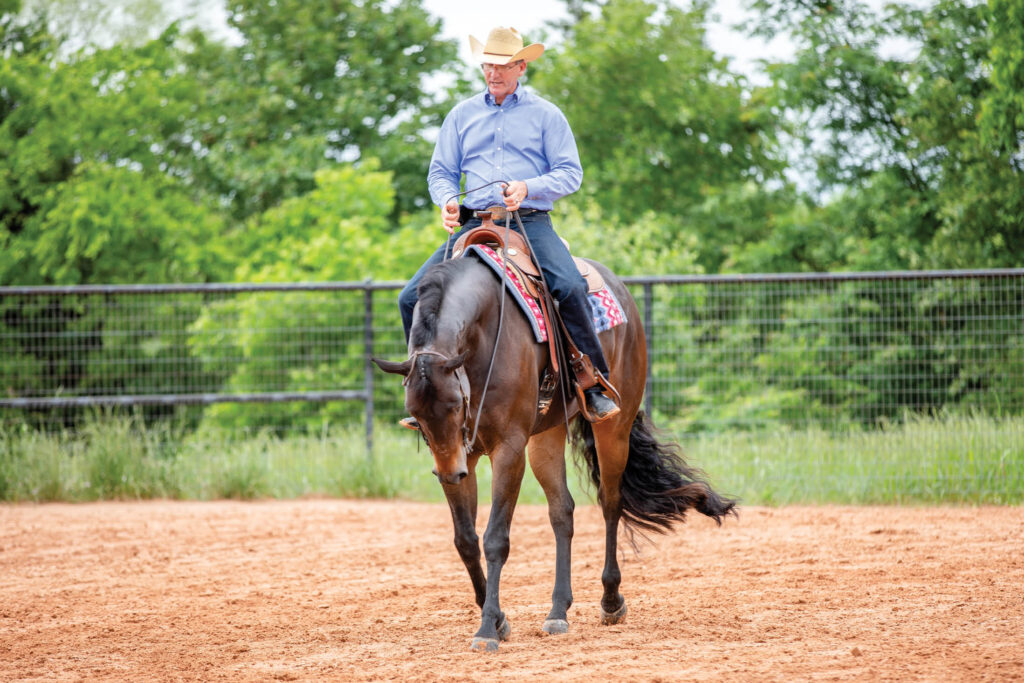Learn why world champion trainer Robin Frid’s daily riding routine always begins with connection to ensure his horse’s body position is where it needs to be.
Horsemanship is more than just sitting on top of your horse like a stick figure. Being afraid to move your body out of the “perfect” position. It’s supposed to be a class that showcases your ability to connect with your horse. To demonstrate how you work together in partnership to navigate a series of maneuvers.
You should recognize the pivotal role that connection plays in every aspect of riding. It’s not just about mastering maneuvers or executing flawless transitions. It’s about having a conversation with your horse through subtle cues, body language, and mutual understanding. It doesn’t matter if you’re trotting down the trail or navigating a challenging horsemanship pattern. The importance of connecting with your horse cannot be overstated.

The Foundation of Athleticism
A solid foundation is essential for a sturdy house. A horse’s good body position is the cornerstone of their athleticism. Whether a horse is going over a jump, powering down a racetrack, or spinning in a reining pattern, the quality of their movement starts with their body position. This rule holds true across disciplines. To put it simply, if a horse’s body isn’t aligned, his performance will suffer, no matter how talented he is.
For me, the daily routine begins with ensuring my horse is in an optimal body position. From the moment I start walking and trotting around, I’m already working on establishing a connection. By making sure my horse’s body is positioned correctly from the first step of my ride, I lay the groundwork for effective communication throughout my entire ride.
It doesn’t matter if I’m warming my horse up at home, or I’m getting a horse ready to step foot into the show pen. The first couple moments of my ride are going to stay the same because if I’m not in sync with my horse, I’m not going to be able to accomplish anything.
Communication in the Saddle
Communication isn’t a one-way street; it’s a dynamic exchange that requires both parties to actively participate. Just like any language, communicating with your horse has its own vocabulary of cues. From the slight shift of weight in the saddle to the gentle squeeze of the leg, every cue sends a message to your horse.
Often non-pro riders mistakenly believe that winning a horsemanship class is all about maintaining a picture-perfect position in the saddle. While good posture is essential, horsemanship is about having the ability to effectively communicate with your horse and, more importantly, about your horse’s ability to understand and accept that communication throughout a pattern.
If I send a cow into the arena and your horse spooks at it, I want to know that you have the ability to stay on and keep control of your horse in that situation. If you’re riding like a stick figure in the saddle, you’re more likely to come off your horse or lose control of him.

A Judge’s Perspective
A good rider understands that things don’t always go according to plan when you’re in the show pen. Perhaps you’re in the middle of a pattern and your horse loses his frame, or a sudden distraction causes his focus to come off you. This is where the depth of your connection truly shines. It’s not about maintaining a rigid, picture-perfect posture. It’s about your ability to stay in sync with your horse, provide the necessary guidance, and regain that lost position. A rider who can adapt, connect, and communicate effectively will shine in these moments.
And don’t let the top-level riders fool you. While it might look like they’re always stay in that picture-perfect horsemanship position, these riders continue to always stay functional in the saddle.
It takes years of riding and strengthening your body to be able to do it so effortlessly.
The Small Things
As a judge, I notice this. A rider who goes to their hand and leg and puts a horse back into the correct position is going to mark higher than a rider who stays in that “perfect” horsemanship position but continues to let their horse stay out of frame. It doesn’t matter how talented your horse is or how easily he can perform certain maneuvers. If you don’t show me the ability to connect with your horse and get his position back when needed, it’s going to reflect in the overall score. Judges understand that true horsemanship goes beyond the superficial. It’s about showing that you can establish and maintain a connection with your horse, even when faced with the unexpected.
This rule doesn’t just apply to horsemanship, either. Connection with your horse is important regardless of what kind of event you compete in. You should be able to easily communicate with your horse, no matter what. If that’s in trail class, riding a reining pattern, or even going down the fence to work a cow.






